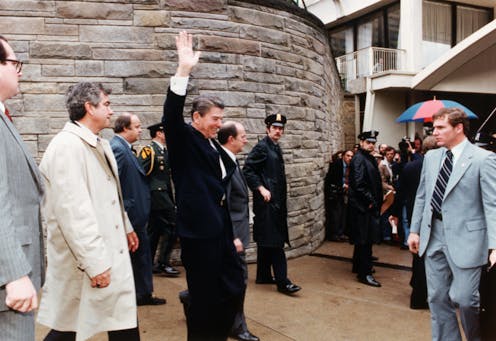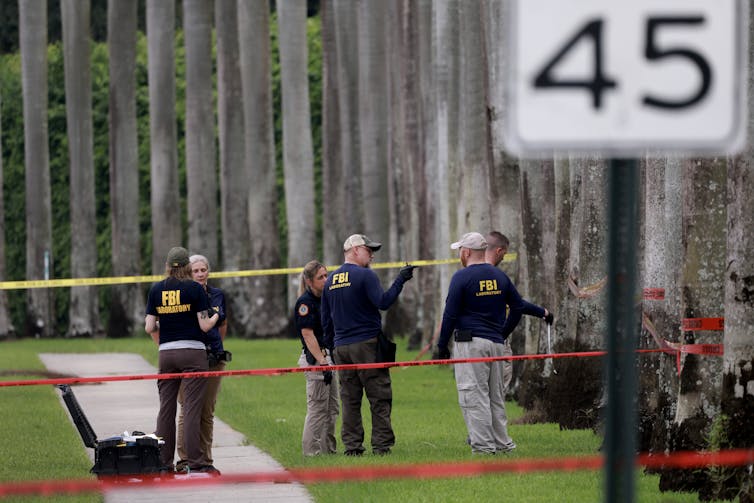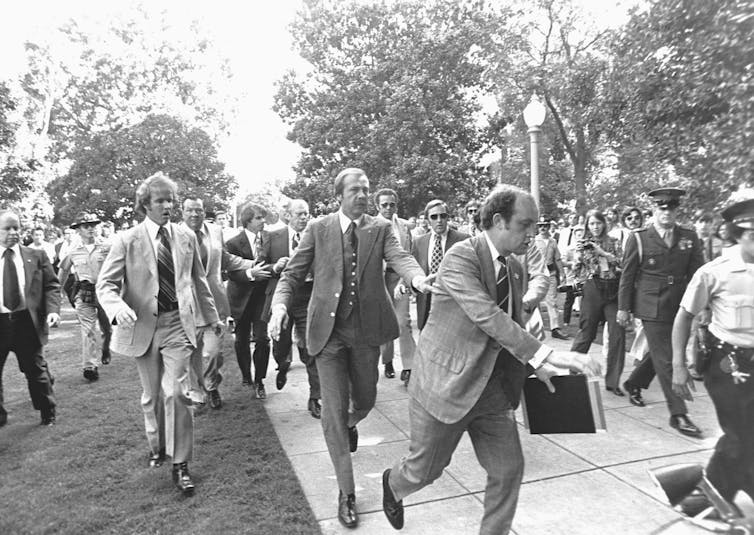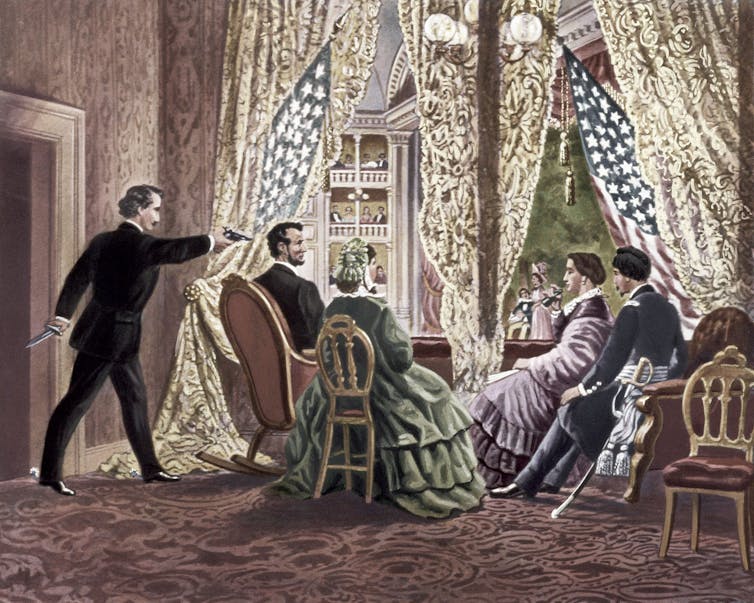Trump’s second assassination attempt is shocking, but attempts on presidents’ lives are not rare in
While 4 presidents have been killed, many others have been victims of plots to end their lives − sometimes because of political anger, but many other times for incomprehensible reasons.

Former President Donald Trump survived his second assassination attempt on Sept. 15, 2024, marking the latest chapter in a long history book. Presidential assassination attempts, whether successful or not, are fairly commonplace in American history.
There have been 45 men elected president since the country’s founding. And 40% of them have experienced known attempts on their lives. Four presidents – Abraham Lincoln, James A. Garfield, William McKinley and John F. Kennedy – have been assassinated.
While Trump and Theodore Roosevelt were both former presidents when they were shot, Ronald Reagan was injured while in office, with a would-be assassin almost ending Reagan’s life in 1981.
Thirteen others – Andrew Jackson, William Howard Taft, Herbert Hoover, Franklin Delano Roosevelt, Harry Truman, Richard Nixon, Gerald Ford, Jimmy Carter, George H.W. Bush, Bill Clinton, George W. Bush, Barack Obama and Joe Biden – have had known plots or failed attempts to end their lives.
Many were subject to multiple attempts, and it is likely the public was never informed of other attempts upon them or other presidents.
Presidents symbolize the ideals of ourselves as Americans. They often act as the physical embodiment of our country, their political party and its values. When individuals are unhappy with the United States or its policies, some choose to express their opinions in violent ways. Those who choose to assassinate a president inadvertently humanize the very presidents they want to kill.

A common thread
Every presidential assassination or attempt has been made with a firearm. With the exception of Gerald Ford’s two attempted assassins, all the perpetrators have been male.
This includes Trump’s two assailants, men who were once enthralled by but seemingly grew disenchanted with aspects of modern politics.
The Secret Service thwarted an armed man hiding at a Trump golf course in Palm Beach, Florida, on Sept. 15. The Secret Service fired at the person, who fled in a car before he was apprehended and arrested.
This came just two months after Trump was wounded at a Pennsylvania rally on July 13 by a young man who attempted to kill Trump with a gunshot to the head.
Many presidential assassination attempts seem incoherent to anyone except the perpetrator.
A man named Charles Guiteau killed Garfield in 1881 because he wanted to be awarded a patronage position in government.
John Wilkes Booth killed Lincoln as part of a larger plot attempting to create chaos to help reignite the “Southern cause” and support for slavery. On the same night Lincoln was killed in 1865, his secretary of state, William Seward, was attacked but survived.
At the same time, the plot was for then-Vice President Andrew Johnson to also be killed by another man, George Atzerodt, who instead got drunk and threw the knife in a gutter.
Booth and his co-conspirators hoped that these politicians’ almost simultaneous deaths would throw the Union into disarray, with an unclear path of succession. Their plan fell apart, and with Johnson alive, the nation’s clear path of presidential succession remained intact.

A near miss
Half a century later, while former President Theodore Roosevelt was campaigning for a third presidential term in 1912, he was shot in Milwaukee, Wisconsin.
Though he was shot at almost point-blank range, Roosevelt was, in a way, saved by his poor eyesight and long-winded nature. Roosevelt had a 50-page speech folded in his pocket, as well as his steel eyeglass case. Both items slowed the bullet enough that it just entered his chest but not deeper than the muscle.
Roosevelt famously proceeded to give a 90-minute speech before leaving for the hospital.
One of the closest comparisons to Trump’s two recent assassination attempts is when two women tried to kill President Gerald Ford in September 1975.
Both Trump and Ford were the targets of well-publicized assassination attempts within a short period of time, and both were targeted by individuals with logically unclear motives.
Lynnette “Squeaky” Fromme, a one-time member of the Manson family, a well-known cult in the 1970s, attempted to kill Ford in order, she claimed, to save California redwood trees.
At the time, the Environmental Protection Agency was warning people about worsening smog’s effects on the environment, leading her to believe assassination was the only way to preserve the trees. Fromme dressed entirely in red, went to Sacramento where the president was visiting, aimed and fired at him within a 2-foot range.
Except the gun didn’t fire.
Bystanders heard a click, since she had not put a round in the chamber, likely because she did not know much about guns. After that first attempted shot, Secret Service intervened. Later, Fromme claimed she did not want to shoot the president.
Seventeen days later, on Sept. 22 in San Francisco, Sara Jane Moore shot at Ford from about 40 feet away and missed. Her second shot missed as well, this time because a bystander, Oliver Sipple, grabbed the gun, forcing the shot to go wide, injuring a taxi driver.
Finally, Reagan survived an assassination attempt by John Hinckley Jr. on March 30, 1981. Hinckley was obsessed with the popular film “Taxi Driver” and, in particular, the character played by actress Jodie Foster.
He believed that if he could impress Foster, she would date him. As Reagan left the Washington Hilton hotel, Hinckley fired six shots in two seconds. One shot deflected off the car and into the president’s left side, hitting his lung. One of the funnier lines Reagan would later repeat was born that day, when he looked at doctors prepping for surgery and said, “I just hope you’re Republicans.” One doctor replied, “Today, Mr. President, we’re all Republicans.”

The best and worst of us
Throughout history, American presidents and occasionally candidates have been targeted by gunmen and other potential attackers to express their unhappiness about the government. The rationales for these assassins’ actions vary from simply chaos to delusions anointing the assassin, or would-be assassin, a heroic main character.
Presidential assassinations reflect the best and the worst of people simultaneously. The violence itself shows the worst of society, but Americans often seem at their best in the aftermath. Like Reagan’s surgeons once recognized, politics should never supplant humanity or be more valued than a person’s health and safety.
Shannon Bow O'Brien does not work for, consult, own shares in or receive funding from any company or organization that would benefit from this article, and has disclosed no relevant affiliations beyond their academic appointment.
Read These Next
Pardons are political, with modern presidents expanding their use
Trump and Biden have issued pardons at a faster clip than their predecessors. Many of their decisions…
Christmas trees are more expensive than ever in Colorado — what gives?
Most Christmas trees are imported from other states, which drives up costs.
Getting peace right: Why justice needs to be baked into ceasefire agreements – including Ukraine’s
Just war theory, a centuries-old field of ethics, deals with how and when to start conflicts. It can…






